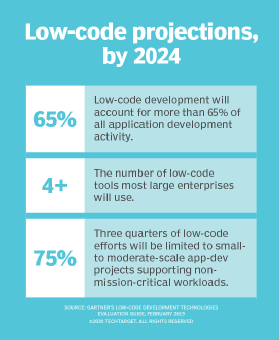How low-code development accelerates digital transformation
Enterprises that don't embrace digital transformation invite competitors to carve up their business. Here's how low-code development can help a business become digitally adept.
Organizations embark on digital transformations for many reasons: identify business opportunities, personalize customer experiences, streamline workflows and processes, adopt data-driven behaviors and explore emerging technologies. Typically, a digital transformation requires an organization to:
- develop new applications, integrations and analytic capabilities;
- modernize applications for the cloud;
- build customer-facing mobile applications; and
- automate workflows.
To accomplish these tasks, Agile teams must quickly deliver minimum viable applications, and then improve them based on customer feedback. IT departments adopt microservices architectures, public cloud migrations and DevOps automation.
Unfortunately, traditional software development typically cannot keep up with the speed and scale of digital transformation, and most organizations lack the staff and skills to build and support these initiatives. Low-code development practices and tools come into play to address those needs.
Low-code, no-code and citizen development: Different takes on digital transformation
Low-code, no-code and citizen development methods help organizations rapidly develop, deploy and maintain secure applications and optimize user experiences. Each takes a different approach to support digital transformation efforts.
Low-code generally aims to help practitioners -- application developers, engineers, data scientists and system administrators -- improve their productivity and quality through tools and higher-level abstractions, compared with using traditional software development languages and tools. Typically, this involves a drag-and-drop interface to build a data pipeline, mobile-user interface, workflow, integration or data visualization. Coding paradigms customize this experience, such as the ability to extend the platform using native JavaScript, Java or other languages, or through proprietary scripting or meta-language capabilities that handle customization and configuration.

No-code focuses on visual workflow tools, drag-and-drop user interfaces, WYSIWYG user interface development tools, configurations, formulas and short expressions to develop automations, applications, integrations and data visualizations. Sometimes this involves APIs, but the objective is to help deliver capabilities without developers writing code. The target audience may be technologists but could also be line-of-business workers and so-called citizen developers who possess and require little, if any, coding knowledge.
Citizen development is a culture and practice that enables people outside of a centralized data or technology department to build and support applications. Examples include marketers moving data between SaaS platforms, operational teams developing departmental workflows or service teams building applications connected to enterprise systems. They enable organizations to successfully expand technology capabilities to business teams, but citizen development programs require IT, data and operational governance.
Sometimes these approaches happen in concert; other times the lines blur. That's true of low-code development platforms as well -- some offer both low-code capabilities for developers and separate no-code functions for business teams. Meanwhile, several enterprise and SaaS platforms bundle low-code and no-code capabilities into their broader platforms.
Benefits of low-code in digital transformation
So how exactly do low-code, no-code and citizen development accelerate an organization's digital transformation efforts to develop applications, workflows, integrations and analytics? Here are some general benefits:
- Accelerate requirements gathering. Development teams can prototype experiences in low-code platforms and spend less time developing wireframes and complex designs. End users that see a quick prototype are more likely to provide feedback on what they really want, which leads to more detailed requirements.
- Iterate with agility. Agile methodologies are critical to digital transformations, as they enable teams to improve applications based on feedback in every sprint. Low-code fosters rapid development and abstracts many technical details; agile teams can demo improvements to stakeholders at sprint reviews and more quickly deliver a viable product faster.
- Optimize mobile experiences. Low-code platforms often include capabilities to optimize web, mobile and tablet experiences. Many bundle best practices in user experiences and design.
- Integrate with SaaS without coding. Low-code doesn't just enable application development; it also simplifies integration of data and workflow into SaaS platforms. If you need to connect an application to CRM, marketing and collaboration tools, many low-code platforms include such integrations. Deeper or broader integrations between applications may require low-code integration platforms, some software development and coding expertise.
- Develop with guardrails. Application development is more than just coding; it's the implementation of practices to ensure the reliability, performance and security of the experience. Low-code development and associated tools abstract away some of this complexity, but only up to the point where developers embed custom code in the application.
- Deliver DevOps support. In addition to enabling rapid development, low-code technologies take a lot of the heavy lifting out of setting up infrastructure and creating deployment pipelines that custom applications require. Some low-code platforms are SaaS, while others support public cloud deployments and data center hosting options.
- Support and enhance without code's complexities. It's a challenge to maintain and modernize applications, especially when you have to deal with complex, undocumented code. It's often easier to understand the business logic, workflows and data transformations through a visual tool rather than sifting through thousands of lines of code.
Examples of how low-code delivers business impact
Organizations frequently encounter situations such as these:
- A small field operations team needs to schedule fulfillment workflows.
- A marketing department wants to connect customer data to digital marketing tools.
- An internal group that serves customers wants a mobile application, ideally inexpensively developed and supported.
Low-code development's impact on a business can be straightforward, like building applications to replace spreadsheets and collaborations done over email. Other examples are strategic, such as applications connected to ERP, CRM, HR and IT systems to eliminate the need to enter data in multiple systems.
Some of the most important low-code applications are highly episodic. Recent examples include applications tied to COVID and hybrid or remote working protocols.
Other low-code examples illustrate the importance to iteratively improve an application based on user feedback. Data visualization dashboards are great examples of low-code development. People start using them and then come back and ask developers to change graphs, add new data elements and add sorting capabilities.
Digital transformations require exactly these kinds of quick delivery and rapid enhancements. Low-code development provides organizations with additional tools and capabilities to accomplish tasks more efficiently.







